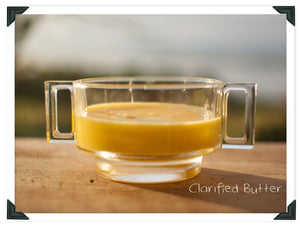Here's a special post for all you butter lovers. Not content with just spreading it on your toast? Clarifying butter means you can cook with it too. You've probably heard the term 'Clarified Butter' but what does that mean exactly? Simply put, the process of clarifying butter removes the milk solids and water, leaving pure butterfat. Clarified butter behaves like cooking oil, but retains some of the butter flavors. Yum!
Without the milk solids and water, clarified butter has a much higher smoke point, so is excellent for cooking things such as pancakes, fritters, and pan-fried fish at high heat. Once clarified, it has a much longer shelf life than fresh butter and will keep in a covered pot in the fridge for up to 6 months.
How to Clarify Butter
- Melt the butter in a wide pan over low heat.
- Once melted, keep the butter gently bubbling at that heat for 10 minutes and skim off any white foam that rises to the surface during that time. The milk solids will sink to the bottom of the pan and form a sediment.
- When the surface is clear and the butter has all but stopped bubbling, remove it from the heat.
- Let it settle for a further 5 minutes so any remaining solids sink to the bottom.
- Pour the clear, golden, clarified butter through a double layer of cheesecloth into a clean jar. Stop pouring once you've run out of the golden liquid and just have white solids left.
- Put the lid on, date and store in the refrigerator. Use within 3 months or freeze
Tips
- Always use unsalted butter as salted butter spits, and the clarified butter can’t be used for pastries and sweet dishes.
- Cultured butter makes a beautifully flavored clarified butter, but it does not have the same keeping properties and should be used within a month.
- Butter loses about a quarter of its volume when clarified, so allow extra butter if you require a certain quantity at the end.
- Store it in a sealed jar in the refrigerator so it does not take on the flavors of other foods.
Clarified butter is used in many different cuisines under many different names. Here are a few names and uses for clarified butter that you might like to incorporate into your cooking:
Beurre noisette
Beurre noisette (hazelnut or brown butter) is the French term for clarified butter. The milk solids that fall to the bottom of the pan are browned slightly, which gives it a nutty flavor. Beurre noisette is traditionally served as a sauce for fish and vegetable dishes.
Drawn Butter
In America, clarified butter is often referred to as drawn butter, and is a favorite accompaniment to seafood suppers of lobster, prawns, crabs or clams. It is also served with corn on the cob and used for basting grilled vegetables, due to its higher smoke point.
Potted Foods
Clarified butter has been used for centuries in the English cookery method of potting food, for the preservation of meat, game birds, fish and even cheese. Food would be cooked in seasoned clarified butter (similar to the French confit method using duck fat) then sealed in an earthenware pot under a further layer of clarified butter to exclude all air. Stored in a cool place, these “pots” would keep for months.
Potted shrimps are still a popular English dish today, served with wholemeal toast or on crackers for an easy and impressive canapé. Melt the same weight of clarified butter as the shrimps and add seasonings of mace or nutmeg, cayenne pepper, sea salt and lemon juice. Add cooked shrimps that have been patted dry and gently reheat them in the seasoned butter.
Pour into small glass jars or ramekins and top with more clarified butter to seal. Stored in the refrigerator, potted shrimps will keep for at least 2 weeks. Put lids on the jars to prevent the butter from taking on other flavors. Serve at room temperature for easier spreading.
Ghee
Clarified butter is called ghee in Indian and South-East Asian cookery and is often made from cultured unsalted butter, which imparts the characteristic cultured flavor to the ghee. This cultured clarified butter is used widely in the Ayurvedic diet.
When making ghee the butter is often cooked for a little longer so the milk solids slightly caramelize. This imparts a nutty flavor and color to the finished product. Ghee is sometimes flavored with herbs and spices during cooking to produce flavored ghee. The addition of a curry leaf is one delicious variation.
For more butter making recipes and tips see our Butter Making Kit.
Have fun, and as always we would love to know how you get on making it yourself.

